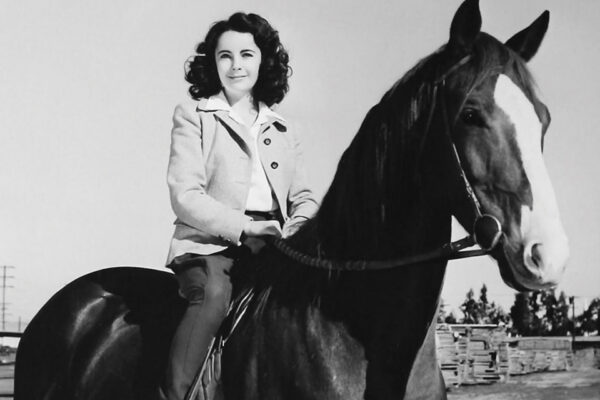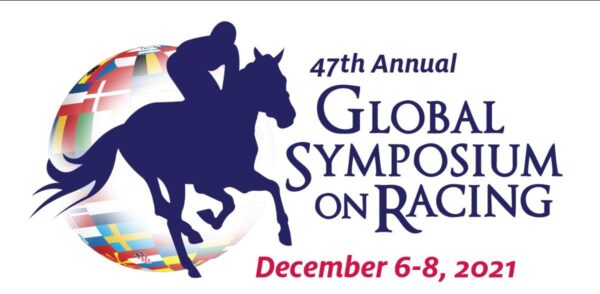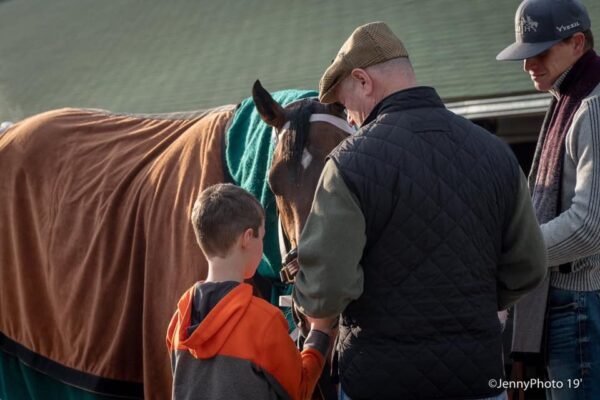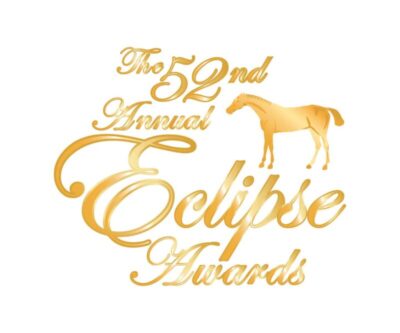
A Celebration of Women in Racing
As a longtime fan of Steve Haskin’s writing and his “Derby Dozen” column that he wrote for Blood-Horse for years I’ve continued to follow him wherever he goes. No, not literally! I’m not a stalker. But, for sure, wherever I can find his writing, I access it. I found this piece on his Facebook page. This homage to women in Thoroughbred racing was just too good to leave to the fate of Facebook since I know many people who have either never been on Facebook or would simply never find this piece there.
Haskin begins with a quote from Velvet Brown (played by Elizabeth Taylor) in the 1944 film, National Velvet: “I think all the time about horses. All day and every night…” which sort of encapsulates how anyone who has ever loved a horse—or horses—has felt at some point in their life. I’m sharing his story here because I know so many people who will relate to those words and also enjoy this retrospective look at women in Thoroughbred racing. Thank you, Steve, for all you do for horse racing and for horse racing fans.
In a year when we are honoring women in sports let’s not forget the impact women have had on horse racing, and it goes far beyond Velvet Brown’s love of horses and her beloved The Pie or Marguerite Henry’s classic Misty of Chincoteague that captured the hearts of millions of young girls. But both did help form the foundation of what was to come as those young girls grew to womanhood and used that love of horses to impact the sport in a profound way.
Oscar Wilde wrote:
“The tragedy of old age is not that one is old, but that one is young.”
I wrote in John Henry’s biography that the tragedy of his growing old and weak as he lived into his thirties was that, inside, he was still that young spirited colt who was always so full of life and devilment. And that is why horses are so magical to us; because they have the power to keep the fire of youth burning inside us regardless of our age, and that applies to many of my Facebook friends who have been lifelong horse lovers and have never lost their childhood passion for these amazing animals.
It was Velvet Brown who also provided the words that inspired so many of these horse-crazy young girls and ignited that passion.
How many young girls over the years have been moved by Velvet’s words:
“I think all the time about horses. All day and every night. I want to be a famous rider. I should like to race. I should like to have so many horses that I could walk down between the boxes (stalls) and ride what I choose. Every day I pray to God to give me horses…wonderful horses.”
Those words, as Velvet cradled her head against a wooden railing and gazed off into some sort of magical dreamland, have lured young girls into the world of “wonderful horses” for almost 80 years.
The seed that Velvet Brown planted in National Velvet, along with a number of classic horse-related books for young readers, manifested itself on a national scale in the early 1960’s when a 12-year-old girl named Heather Noble formed the Kelso fan club, named Kelsoland, whose membership grew into the thousands. Young girls across the country, many unable to share their love of horses with others, now had found a home and were united through regular newsletters regarding all aspects of their beloved Kelso’s life, while providing interaction between members. The great gelding’s owner, Mrs. Allaire DuPont, would name Kelso’s half-sister Heather Noble.
There have been many equine heroes to emerge since Kelso, but it wasn’t until racing fans, mostly females, had access to social media, mainly Twitter, Facebook, and blogs, that the intense passion for horses bubbled to the surface on a major scale, thanks to the active group “Friends of Barbaro” or “Fans of Barbaro” that led to numerous horse rescues and extensive donations to Laminitis research, and also to the larger than life heroines Zenyatta and Rachel Alexandra, which began a seething rivalry, not between the two horses, but their zealous factions.
There was a book published several years ago by Carolina A. Shearer titled, Women Will Save the World. Could it be that it will be women who ultimately help save the racing world and its equine stars? After all, men, despite their attempts, haven’t done much to prevent the decline of Thoroughbred racing in popularity or perception.
It has been through the efforts of so many horse-loving females that the number of horse rescue organizations across the country has continued to increase. Females have also been the driving force in the fight against horse slaughter and saving the wild mustangs, and are mainly responsible for the ever-increasing work of the Thoroughbred Aftercare Alliance, which is helping to unite and organize rescue organizations and racetracks in the protection of racehorses.
Can one put a price on the passion and love of horses that females bring to the sport?
They travel hundreds, sometimes even thousands, of miles to see horses like American Pharoah, California Chrome. Zenyatta, and Rachel Alexandra in the flesh, with many bringing signs and posters and providing a great deal of the electricity that runs through the track at these historic events. You didn’t see that in the 40’s, 50’s, and 60’s when the huge weekend crowds were dominated by middle-aged men in suits and hats. These were mostly $2 bettors taking advantage of the only gambling outlets outside of Las Vegas. Sure there were many pure racing fans who loved seeing great horses, but in a world now inundated with gambling venues, we need these passionate women to attend the races just for the love of the sport and its heroes. We see what racetracks look like on a weekday without them.
No, they are not going to singlehandedly save the sport, but they are helping to give it the necessary exposure to keep it in public awareness and keep it relevant. Pity Sports Illustrated’s editors for selecting Serena Williams as its Sportsperson (formerly Sportsman) of the Year over American Pharoah after the fans, headed by a mass influx of female votes, overwhelmingly voted the colt the honor in the fans’ poll. And pity TV and radio sports show hosts who mocked the thought of a horse being awarded. They all incurred the wrath of horse and racing lovers, mostly females, who launched full-fledged attacks on Twitter etc. As long as that kind of passion burns brightly, so will racing.
I have written numerous biographical features over the years and it seems when I interviewed males, many of them became passionate about the sport and the horses from their fathers taking them to the track as youngsters. Many owners and breeders were successful in business and became involved in racing as an escape from their work, to be involved in a sport, or just to fuel their competitive fires. When I interviewed females, the majority of them grew up with horses, riding them, showing them, or just working closely with them. The love of horses was ingrained in them at an early age and the bond formed continued to grow throughout their lives. Many horse-loving young girls who went on to other endeavors as adults and couldn’t be Velvet Brown were content to dream about being Velvet Brown.
I was amazed at the spiritual effect Zenyatta had on women, and wrote about several of them who told their personal stories how the great mare affected their lives and helped them through tragedies, illnesses, and other crises.
Trainer John Shirreffs also was amazed at the outpouring of emotion that Zenyatta inspired.
“There are ladies who come to the barn and they’re literally shaking,” he said at the time. “They’re sweating and crying. One lady, who is a school teacher from Santa Barbara, said the first time she came to see Zenyatta she was in a wheelchair; she couldn’t walk. She said Zenyatta inspired her to push herself and try to walk. Before we left for Kentucky, she visited the barn and she was carrying three cameras and was walking.”
There were many other such stories in that column from women that demonstrated the ethereal relationship that can develop between humans and horses.
American Pharoah apparently had a similar effect. One woman in particular I wrote about following the Travers was Shara Goldman Eltringham, who actually gave me a new perspective on the deification of racehorses, even having witnessed the Zenyatta craze.
She wrote:
“Since Friday, my grandfather passed away, I took my dog to the ER vet, my 11-year-old daughter to the ER with a broken collarbone, and I just found out my mother is now in the ER and is being admitted to the hospital. My husband lost his job six weeks ago. I have plenty to be anxious about. But watching American Pharoah run is not one of them. We scraped up enough cash for two general admission tickets and gas money and are driving five hours from central Pennsylvania just to get a glimpse of him. Win or lose, I plan on simply basking in the greatness that is American Pharoah.”
This is another example of the passion that Velvet Brown instilled in young girls through her all-consuming passion for horses.
But a woman’s passion for racing is not confined to inspirational stories and schoolgirl infatuation.
Although men have controlled the business side of racing, whether running the racetracks or major organizations, has there ever been a bigger mover and shaker than Marge Everett, who ran Arlington and Washington Parks and later Hollywood Park with an iron fist? Everett was known for her aggressive and innovative marketing prowess. She came up with the idea of merchandise giveaways, and her tote bag day in 1980 drew an all-time track record attendance of 80,348. She also initiated a carryover provision to the pick six, then known as the perfect six, in 1983; and was a driving force in luring the first Breeders’ Cup to Hollywood Park in 1984, while enticing numerous big-time celebrities to attend the event and present the winning trophies, which helped greatly establish its popularity. Ironically, one of the celebrities to present a Breeders’ Cup trophy was Elizabeth Taylor, who played Velvet Brown in National Velvet.
Stella Thayer has been the owner of Tampa Bay Downs and president of the Thoroughbred Racing Association, and in 2005 was named president of the National Museum of Racing and Hall of Fame. Have there been any more beloved figures in racing than Penny Chenery and Marylou Whitney? In 2012, the New York Racing Association named Ellen McClain as its first female president. The three Triple Crown winners of the 1970s were either owned or co-owned by women – Penny Chenery, Karen Taylor, Sally Hill, and Patrice Wolfson.
Karin De Francis has been a powerful figure in Maryland racing for years. New York-based Karen Murphy is one of the most prominent racing attorneys in the country, handling the majority of high-profile cases.
Des Moines attorney Maggi Moss has built one of the most successful racing stables in the country through her lifelong love of horses, becoming the first female to be leading owner in the country in 2006 and was one of the three finalists for an Eclipse Award. In 2011, Moss won with an amazing 34 percent of her starters. She is now one of the leading advocates for finding horses homes after their racing life.
Georganne Hale was first racing secretary of a Triple Crown race and the second was her protegee Jillian Sofarelli Tullock.
Mary Scollay and Patricia Hogan are two of the most high-profile and respected equine veterinarians in the country and there are and have been many others. In fact, the vast majority of veterinary students in colleges and universities across the country are female, a trend that began over a decade ago. In 2010, for example, 77 percent of new veterinarians coming out of school were female, and that figure pertains to equine veterinarians as well.
Arguably the most influential and innovative person in the world of television is former HRTV executive producer Amy Zimmerman, who has won a number of awards for her documentaries, many of them depicting the human interest side of racing. Zimmerman also served in executive roles with NBC and Santa Anita Park in her more than 25 years in the industry. Several years ago she was nominated as a finalist for the 2015 Women Making a Difference.
Some of the women pioneers in the field of racing journalism include Elinor Kaine Penna, Jane Goldstein, who became head of publicity for Santa Anita, Maryjean Wall, Pohla Smith, Jennie Rees, and perhaps the true pioneer Mary Jane Gallaher, who covered racing for the Lexington Leader in the 1950s, wrote for the Blood-Horse and Thoroughbred Record and reportedly was the first female allowed in the Churchill Downs pressbox. In 1960, Elinor Kaine became the first female sportswriter to exclusively cover the NFL and did the Sunday Pre-Game show before NFL games on CBS with Pat Summerall and Jack Whitaker from 1960-71 in addition to writing columns of horse racing. Tracy Gantz has been a writer, copy editor, magazine editor,and currently serves on the Racing Hall of Fame Nominating Committee.
Laura Hillenbrand, author of Seabiscuit, has emerged as one of the most prominent best-selling authors in the country. Jennifer Kelly is becoming one of the sport’s pre-eminent historians, first with her popular book on the life of Sir Barton, racing’s first Triple Crown winner, and is now currently working on a book about the great Woodward family Triple Crown winners Gallant Fox and Omaha called The Foxes of Bel Air. One of the truly great racing historians is Mary Simon, who has won three Eclipse Awards for her superb writing on the history of the sport. Although not on a professional level, the blog The Vault by Abigail Anderson is a must read for history lovers with its amazing research, witing and rare old photos and videos.
And there are authors Lynda Sasscer Hill and J. Carson Black who have become today’s Dick Francis with their thrilling racing mystery novels.
Females have made an impact in all fields.
Ada Gates Patton was the first female to be a licensed farrier. Also, some of the sport’s great artists and photographers have been women.
Former exercise rider Charlsie Cantey became one of the most recognizable figures on TV in the 1970’s and 80’s, serving as analyst for NYRA stakes as well as the Triple Crown events and the Breeders’ Cup. She was seen on every major network, including NBC, CBS, ABC, and ESPN and was a reporter for ABC’s Wide World of Sports and USA’s Westminster Kennel Club. She has paved the way for many of today’s female racing analysts along with Sharon Smith of ESPN.
Today, female racing analysts, many lifelong horsewomen, are major influences on the sport, such as Christina Blacker, Gabby Gaudet, Millie Ball, Maggie Wolfendale, and Acacia Courtney. Britney Eurton of TVG has used her knowledge and background in racing and her contagious on-air persona to be a leading racing personality on NBC. Caton Bredar is widely established as one of the most knowedgeable racing analysts in the country and this year was named to the Hall of Fame Nominating Committee, along with Alicia Hughes, former racing writer and current director of communications for the National Thoroughbred Racing Association.
Horse-crazy girls who went on to become jockeys and then major TV personalities in racing include Jeannine Edwards, Donna Barton Brothers, and Zoe Cadman. Edwards, like Cantey, has branched off into other sports.
Female jockeys have a come a long way since 1969 when Diane Crump became the first jockey to ride in a pari-mutuel race in North America and Barbara Jo Rubin became the first to win race. They all followed equestrian champion and Olympic medal winner Kathy Kusner, who was the first female to get her jockey’s license.
Since then we have had many top female jockeys and trainers, with the legendary Hall of Famer Julie Krone becoming the first female rider to win a classic, capturing the 1993 Belmont Stakes aboard Colonial Affair. Krone added the Breeders’ Cup Juvenile Fillies.
Rosie Napravnik won two Breeders’ Cup races (Distaff and Juvenile) and the Kentucky Oaks twice. Abigail Fuller became the first female jockey to win the Filly Triple Crown, taking the Acorn, Mother Goose, and Coaching Club American Oaks on Mom’s Command in 1985. Chantal Sutherland became the first female rider to win the historic Santa Anita Handicap. Emma-Jayne Wilson captured Canada’s greatest race, the Queens Plate. England’s Hollie Doyle set a record for most winners in a single year by a female jockey, was voted BBC’s Sports Personality of the Year, and was one of the stars of the 2020 Royal Ascot meet.
In steeplechasing, Mary Ryan Hirsch became the first female rider to finish in the money (2nd) at a pari-mutuel meet (Fair Hill) in 1969. For the next several decades she became a fixture at NYRA hosting its Breakfast at Belmont and Breakfast at Saratoga programs.
And there was trainer Jenine Sahadi winning back-to-back Breeders’ Cup Sprints in 1996 and 97 and Kathy Ritvo, returning from a near-fatal heart condition that required a heart transplant to become the first female to win the nation’s richest race, the $5 million Breeders’ Cup Classic. Linda Rice pulled off one of the great shockers by dethroning the mighty Todd Pletcher as leading trainer at Saratoga in 2009, the first female trainer to achieve that feat. Shelley Riley came from the California fair circuit to finish second in the Kentucky Derby with Casual Lies. Other female winners of the Breeders’ Cup Sprint are Maria Borell and Carla Gaines, while Laura de Seroux captured the Breeders’ Cup Distaff with Horse of the Year Azeri.
A mention must be made of Arlene Phillips, who was the leading trainer at Prescott Downs several times in the early ’70s when you rarely saw a female trainer, never mind one who was a leading trainer. It just so happened that the horsemen’s banquet where the leading trainer was to receive a belt buckle was canceled due to insufficient funds and Phillips received her belt buckle unceremoniously. A coincidence?
And it all started Mary Hirsch (McLennan), daughter of legendary trainer Max Hirsch who became the first female to obtain a trainer’s license in 1934 and the first female trainer to run a horse in the Kentucky Derby (1937).
These are just some of the major accomplishments by women in racing, and it is just the tip of the iceberg.
For the sake of the horses and the future of the sport, let’s hope so, because in many ways, Velvet Brown has grown up.
SUBSCRIBE NOW, TO GET NEW POSTS FROM DONNA, DELIVERED TO YOUR INBOX.



2 Comments
Alice L Marold, DVM
Dear Donna Brothers. I was a velvet brown, and at 70 continue in my equine practice of 45 years. Mostly, though, I respond secondary to your letter to the commissioners retweeted on Ray Paulick. I CANNOT believe The Report had nasty replies for doing the ONE RIGHT THING. Nobody but those writers has an ounce of courage not to dance around this thing. I applaud them ,and you, and Team Valor, and everyone else who found this appalling; hopefully horse owners are forewarned now about Ms. Cobb and her career will fade on its own. THANK YOU.
Donna Brothers
Dr. Marold,
Thanks so much for your comments and, more importantly, your love of the animals.